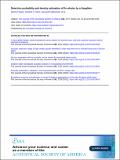Files in this item
Detection probability and density estimation of fin whales by a Seaglider
Item metadata
| dc.contributor.author | Fregosi, Selene | |
| dc.contributor.author | Harris, Danielle V. | |
| dc.contributor.author | Matsumoto, Haruyoshi | |
| dc.contributor.author | Mellinger, David K. | |
| dc.contributor.author | Martin, Stephen W. | |
| dc.contributor.author | Matsuyama, Brian | |
| dc.contributor.author | Barlow, Jay | |
| dc.contributor.author | Klinck, Holger | |
| dc.date.accessioned | 2023-04-20T23:48:19Z | |
| dc.date.available | 2023-04-20T23:48:19Z | |
| dc.date.issued | 2022-10-21 | |
| dc.identifier | 281992727 | |
| dc.identifier | 386a64f1-7451-4fd4-83d9-bf9caf339988 | |
| dc.identifier | 85140849545 | |
| dc.identifier | 000875737000001 | |
| dc.identifier.citation | Fregosi , S , Harris , D V , Matsumoto , H , Mellinger , D K , Martin , S W , Matsuyama , B , Barlow , J & Klinck , H 2022 , ' Detection probability and density estimation of fin whales by a Seaglider ' , Journal of the Acoustical Society of America , vol. 152 , no. 4 , pp. 2277-2291 . https://doi.org/10.1121/10.0014793 | en |
| dc.identifier.issn | 0001-4966 | |
| dc.identifier.other | Jisc: 691950 | |
| dc.identifier.other | ORCID: /0000-0003-1447-1420/work/122216109 | |
| dc.identifier.uri | https://hdl.handle.net/10023/27449 | |
| dc.description | Funding: Funding for this work was provided by Living Marine Resources Program Grant No. N39430-14-C-1435 and Office of Naval Research Grant No. N00014-15-1‐2142. S.F. was supported by the Department of Defense National Science and Engineering Graduate Fellowship. This is Pacific Marine Environmental Laboratory (PMEL) Contribution No. 5101. | en |
| dc.description.abstract | A single-hydrophone ocean glider was deployed within a cabled hydrophone array to demonstrate a framework for estimating population density of fin whales ( Balaenoptera physalus) from a passive acoustic glider. The array was used to estimate tracks of acoustically active whales. These tracks became detection trials to model the detection function for glider-recorded 360-s windows containing fin whale 20-Hz pulses using a generalized additive model. Detection probability was dependent on both horizontal distance and low-frequency glider flow noise. At the median 40-Hz spectral level of 97 dB re 1 μPa2/Hz, detection probability was near one at horizontal distance zero with an effective detection radius of 17.1 km [coefficient of variation (CV) = 0.13]. Using estimates of acoustic availability and acoustically active group size from tagged and tracked fin whales, respectively, density of fin whales was estimated as 1.8 whales per 1000 km2 (CV = 0.55). A plot sampling density estimate for the same area and time, estimated from array data alone, was 1.3 whales per 1000 km2 (CV = 0.51). While the presented density estimates are from a small demonstration experiment and should be used with caution, the framework presented here advances our understanding of the potential use of gliders for cetacean density estimation. | |
| dc.format.extent | 15 | |
| dc.format.extent | 2490326 | |
| dc.language.iso | eng | |
| dc.relation.ispartof | Journal of the Acoustical Society of America | en |
| dc.subject | QL Zoology | en |
| dc.subject | GC Oceanography | en |
| dc.subject | NDAS | en |
| dc.subject | AC | en |
| dc.subject | MCC | en |
| dc.subject.lcc | QL | en |
| dc.subject.lcc | GC | en |
| dc.title | Detection probability and density estimation of fin whales by a Seaglider | en |
| dc.type | Journal article | en |
| dc.contributor.sponsor | Office of Naval Research | en |
| dc.contributor.institution | University of St Andrews. Sea Mammal Research Unit | en |
| dc.contributor.institution | University of St Andrews. School of Mathematics and Statistics | en |
| dc.contributor.institution | University of St Andrews. Centre for Research into Ecological & Environmental Modelling | en |
| dc.contributor.institution | University of St Andrews. Arctic Research Centre | en |
| dc.identifier.doi | https://doi.org/10.1121/10.0014793 | |
| dc.description.status | Peer reviewed | en |
| dc.date.embargoedUntil | 2023-04-21 | |
| dc.identifier.grantnumber | N00014-15-1-2142 | en |
This item appears in the following Collection(s)
Items in the St Andrews Research Repository are protected by copyright, with all rights reserved, unless otherwise indicated.

